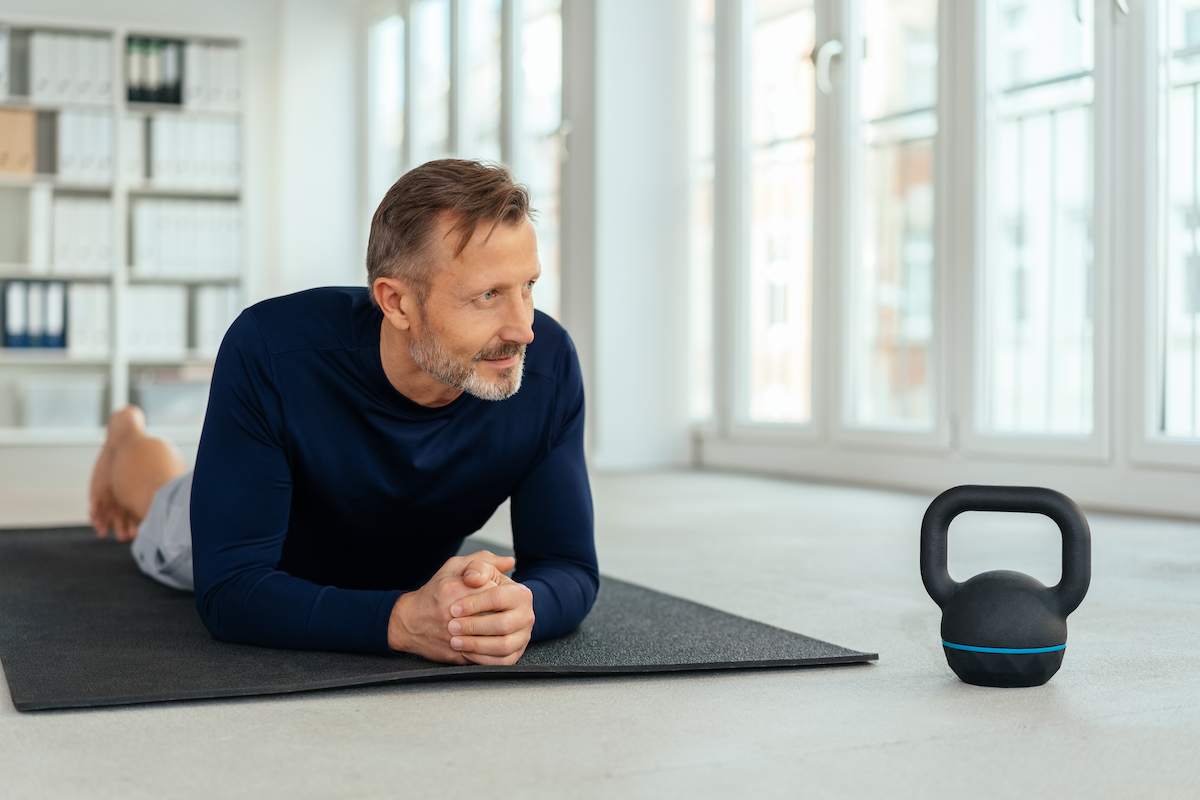Over 60? Here's What Lifting Weights Twice Per Week Does to Your Body

If you believe the weight room is strictly reserved for bodybuilders and hardcore athletes, we come bearing some bad news: you're missing out on some life-changing health benefits. The U.S. Department of Health and Human Services recommends that all adults engage in a moderate to intense muscle-strengthening workout at least twice per week. Yes—that means you, too!
This is especially the case for older adults over the age of 60. We've known for some time that adults start losing more and more muscle mass on an annual basis starting around the age of 30 years-old. According to Harvard Health Publishing, the average middle-aged adult loses three to five percent of their lean muscle mass per-decade. Over the course of a long lifespan most men end up losing roughly 30% of their muscle mass. Even worse: Totally inactive adults experience up to 8% muscle mass loss per decade, in addition to a slowed metabolism and greater fat accumulation.
Though muscle loss with old age is unavoidable, accomplishing some meaningful weightlifting just twice per week can go a long way toward holding off father time. Hitting the weights twice a week represents the perfect schedule in terms of getting your body used to the strain of resistance exercise while also providing ample rest and recovery. "Strength training twice per week is perfect, but once is a waste of time," Michael Boyle, strength and conditioning coach and functional training expert, tells Greatist. "Sure, you can potentially gain strength on one workout a week, but you would continually be sore. Twice a week is less of a shock to the system and allows the body to better adapt."
Remember: Your rest is a big part of the muscular recipe for success. "The thing about strength training is that you don't get better during workouts; you get better in between," Neal Pire, C.S.C.S., an ACSM-certified exercise physiologist, tells Everyday Health. "You should give yourself a day in between strength training to allow your body to recover and rebuild the muscle tissue from the stimulus of lifting or resistance."
Ready to start pumping iron? Read on to learn more about what weightlifting twice per week can do for your body after 60. And for some great workouts to try, see here to read about the 5-Minute Bodyweight Workout That Can Change Your Life After 60.
It Will Add Years to Your Life

Science says the more muscle mass an adult can retain well into old age, the better their chances of increased longevity. Consider one study, published in the Journal of Bone and Mineral Research. Researchers conclude that risk of death by any cause increases dramatically among older adults (65+) with little muscle mass in their arms and legs. The findings were particularly extreme among women. A woman with weak legs and arms was found to be a staggering 63 times more likely to pass away, while men with weak muscles are 11.4 times more likely to die. Over 800 people were assessed for that project.
The notion that weightlifting extends lifespan is supported by another study published in Preventive Medicine. Scientists report adults aged 65+ that lift weights twice per week show a 46% lower mortality rate in comparison to those who do not. "All-cause mortality may be significantly reduced through the identification of and engagement in guideline-concordant ST (strength training) interventions by older adults," the research concludes. And for more on reaping the benefits of exercise in your older years, check out The One Exercise That's Best for Beating Back Alzheimer's.
You'll Have a Healthier Heart

It's well-known that weightlifting helps get the blood pumping and the heart healthy, but you'll be shocked by just how little work you have to put in to reap the cardiovascular rewards. Research including nearly 13,000 adults published in Medicine and Science in Sports and Exercise reports that less than an hour of lifting weights per week is enough to significantly improve heart and overall cardiovascular health.
More specifically, less than an hour on the weight rack per week may reduce risk of heart attack and stroke by 40-70%. That means you can spend just 20 minutes lifting weights for two days per week and put your heart in a much better health position. Furthermore, high cholesterol risk drops by 32%, and risk of developing a form of metabolic syndrome decreases by 29%.
"People may think they need to spend a lot of time lifting weights, but just two sets of bench presses that take less than 5 minutes could be effective," lead study author D.C. Lee, associate professor of kinesiology at Iowa State University, explains. "Muscle is the power plant to burn calories. Building muscle helps move your joints and bones, but also there are metabolic benefits. I don't think this is well appreciated." For some great exercises you can do, see these 5-Minute Exercises for a Flatter Stomach Fast.
You'll Have Stronger Bones

Similar to muscles, bones are known to grow weaker and more brittle the older we get. Luckily, weightlifting and resistance exercises can help strengthen our bones in old age as well. This study, published in the Journal of Bone and Mineral Research, tracked a group of 101 older women (65+) with low bone mass. It took just two 30 minute sessions of high-intensity resistance exercises weekly to improve both bone density and structure, not to mention functional performance, among participants. Even better, not a single woman incurred any adverse side effects or injuries while exercising, suggesting it's never too late to start sweating.
"We believe HiRIT (high-intensity resistance exercises) to be a highly appealing therapeutic option for the management of osteoporosis in postmenopausal women with low to very low bone mass," study authors conclude.
You'll Stave Off Chronic Disease

The fountain of youth is a legend, but weightlifting consistently may be the closest we can get to eternal youth. The medical community has known for decades that with advanced age also comes a greater risk of various chronic diseases including type 2 diabetes, cancer, and heart disease.
Incredibly, scientists report in Frontiers in Psychology that a regular regimen of resistance training and weightlifting can greatly reduce the risk of developing all the age-related chronic diseases mentioned above, as well as mobility issues. "Regular performance of RET (resistance exercise training) improves muscle mass, strength, and function, and can have direct effects on the primary prevention of a number of chronic diseases," the study concludes. "Based on the evidence presented in this narrative review, we propose that RET may serve as another tool in the toolbox for older adults to remain physically active and combat chronic disease risk."
You'll Quit Bad Habits

For any older adults out there looking to kick the habit, taking up weightlifting may be the ticket. A study published in Nicotine & Tobacco Research found that a group of smokers attempting to quit were twice as likely to succeed if they participated in a weight training program. In addition to traditional counseling and nicotine patches to ease the transition, smokers in the lifting group engaged in two training sessions per week for three months.
"We need any new tools that can help smokers successfully quit and it appears resistance training could potentially be an effective strategy," comments lead study author Joseph Ciccolo, Ph.D., an exercise psychologist, researcher and physiologist with The Miriam Hospital's Centers for Behavioral and Preventive Medicine. And for more exercise news you can use, see here for The One Walking Exercise That Can Predict Your Death Risk, Says Study.








